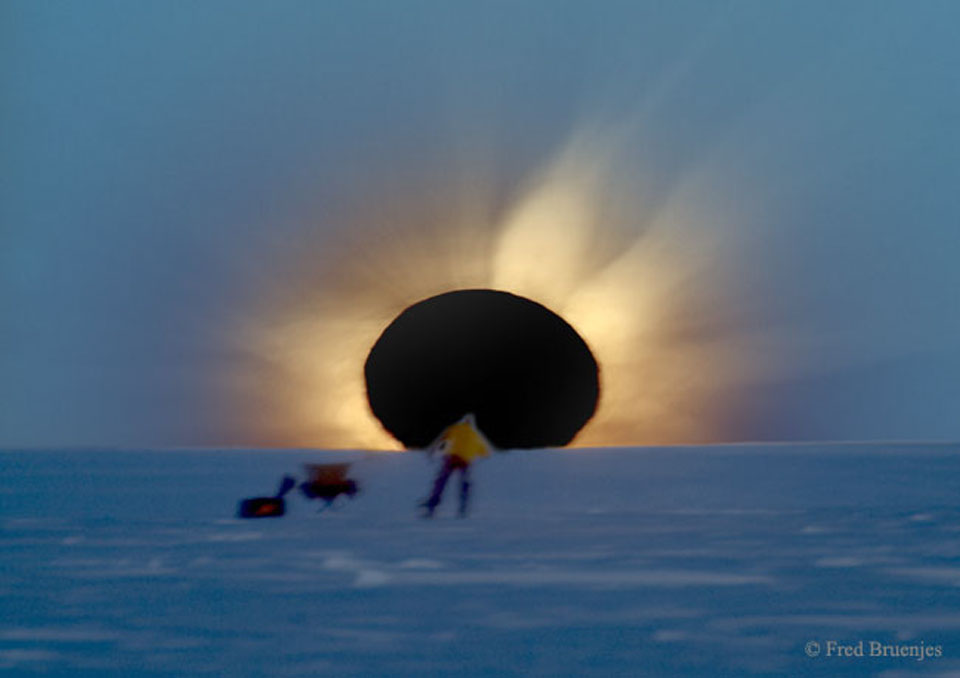10. March 2024
世界盡頭 ê 日全食

探索宇宙1!逐工會揀一幅無仝款 ê 影像抑是相片,𤆬你熟似咱這个迷人 ê 宇宙,閣有專業天文學者2為你3解說4。
- 原始文章:A Total Eclipse at the End of the World
- 影像來源 kah 版權:Fred Bruenjes (moonglow.net)
- 台文翻譯:An-Li Tsai (NSYSU)
[漢羅] 世界盡頭 ê 日全食
為著欲看著日全食,你敢願意行到世界 ê 盡頭? 你若是願意,到時若是有人 比你閣較早到,你敢會感覺意外? 2003 年有一个特別 ê 日全食,tī 這張相片內底,日頭、月娘、南極州、kah 2 个 攝影師,攏排做一逝。 就算這擺 ê 日食發生 tī 這个偏僻 ê 所在,猶是有一陣 日食愛好者,逐到世界 ê 盡頭,就是為著欲 體驗 日頭暫時消失 tī 月娘後壁 ê 超現實感受。 這張相片 是 4 張無仝款 ê 數位影像 合成--ê,主要是欲模擬人類 目睭看著 ê 日食景色。 翕相 ê 時陣,月娘 kah 日頭 做伙出現 tī 南極一个山陵 ê 天頂。 忽然間,天色變暗去,壯觀 ê 日冕 就出現 tī 月娘 ê 邊緣。 意外 ê 是,閣有 翕著 另外一位攝影師咧整理 kha-mé-lah 內底 ê 影像。 倒爿是伊 貯器材 ê kha-báng kah 一隻 通 摺--起來 ê 椅仔。 欲 看著 日食,較簡單 ê 方式就是 4 禮拜後 ê 4 月 8 號,日食會經過美洲一條長長狹狹 ê 路線。
[POJ] Sè-kài chīn-thâu ê Ji̍t-choân-si̍t
Ūi tio̍h beh khòaⁿ-tio̍h ji̍t-choân-si̍t, lí kám goān-ì kiâⁿ kàu sè-kài ê chīn-thâu? Lí nā-sī goān-ì, kàu-sî nā-sī ū-lâng pí lí koh-khah chá kàu, lí kám-ē kám-kak ì-gōa? 2003 nî ū chi̍t-ê te̍k-pa̍t ê ji̍t-choân-si̍t, tī chit-tiuⁿ siòng-phìⁿ lāi-té, ji̍t-thâu, goe̍h-niû, lâm-ke̍k-chiu, kah 2 ê liap-iáⁿ-su, lóng pâi-chò chi̍t-chōa. Tō-sǹg chit pái ê ji̍t-si̍t hoat-seng tī chit-ê phian-phiah ê só͘-chāi, iáu-sī ū chi̍t-tīn ji̍t-si̍t ài-hóⁿ-chiá, jiok kàu sè-kài ê chīn-thâu, to̍h-sī ūi-tio̍h beh thé-giām ji̍t-thâu chiām-sî siau-sit tī goe̍h-niû āu-piah ê chhiau-hiān-si̍t kám-siū. Chit-tiuⁿ siòng-phìⁿ sī 4 tiuⁿ bô-kâng-khoán ê sò͘-ūi iáⁿ-siōng ha̍p-chiâⁿ--ê, chú-iàu sī beh bô͘-gí jîn-lūi ba̍k-chiu khòaⁿ--tio̍h ê ji̍t-si̍t kéng-sek. Hip-siòng ê sî-chūn, goe̍h-niû kah ji̍t-thâu chò-hóe chhut-hiān tī lâm-ke̍k chi̍t-ê soaⁿ-niā ê thiⁿ-téng. Hut-jiân-kan, thiⁿ-sek piàn àm--khì, chòng-koan ê ji̍t-bián to̍h chhut-hiān tī goe̍h-niû ê pian-iân. Ì-gōa ê sī, koh-ū hip-tio̍h lēng-gōa chi̍t ūi liap-iáⁿ-su leh chéng-lí kha-mé-lah lāi-té ê iáⁿ-siōng. Tò-pêng sī i té khì-châi ê kha-báng kah chi̍t chiah thang chih--khí-lâi ê í-á. Beh khòaⁿ-tio̍h ji̍t-si̍t, khah kán-tan ê hong-sek to̍h-sī 4 lé-pài āu ê 4 goe̍h 8 hō, ji̍t-si̍t ē keng-kòe Bí-chiu chi̍t tiâu tn̂g-tn̂g e̍h-e̍h ê lō͘-sòaⁿ.
[KIP] Sè-kài tsīn-thâu ê Ji̍t-tsuân-si̍t
Uī tio̍h beh khuànn-tio̍h ji̍t-tsuân-si̍t, lí kám guān-ì kiânn kàu sè-kài ê tsīn-thâu? Lí nā-sī guān-ì, kàu-sî nā-sī ū-lâng pí lí koh-khah tsá kàu, lí kám-ē kám-kak ì-guā? 2003 nî ū tsi̍t-ê ti̍k-pa̍t ê ji̍t-tsuân-si̍t, tī tsit-tiunn siòng-phìnn lāi-té, ji̍t-thâu, gue̍h-niû, lâm-ki̍k-tsiu, kah 2 ê liap-iánn-su, lóng pâi-tsò tsi̍t-tsuā. Tō-sǹg tsit pái ê ji̍t-si̍t huat-sing tī tsit-ê phian-phiah ê sóo-tsāi, iáu-sī ū tsi̍t-tīn ji̍t-si̍t ài-hónn-tsiá, jiok kàu sè-kài ê tsīn-thâu, to̍h-sī uī-tio̍h beh thé-giām ji̍t-thâu tsiām-sî siau-sit tī gue̍h-niû āu-piah ê tshiau-hiān-si̍t kám-siū. Tsit-tiunn siòng-phìnn sī 4 tiunn bô-kâng-khuán ê sòo-uī iánn-siōng ha̍p-tsiânn--ê, tsú-iàu sī beh bôo-gí jîn-luī ba̍k-tsiu khuànn--tio̍h ê ji̍t-si̍t kíng-sik. Hip-siòng ê sî-tsūn, gue̍h-niû kah ji̍t-thâu tsò-hué tshut-hiān tī lâm-ki̍k tsi̍t-ê suann-niā ê thinn-tíng. Hut-jiân-kan, thinn-sik piàn àm--khì, tsòng-kuan ê ji̍t-bián to̍h tshut-hiān tī gue̍h-niû ê pian-iân. Ì-guā ê sī, koh-ū hip-tio̍h līng-guā tsi̍t uī liap-iánn-su leh tsíng-lí kha-mé-lah lāi-té ê iánn-siōng. Tò-pîng sī i té khì-tsâi ê kha-báng kah tsi̍t tsiah thang tsih--khí-lâi ê í-á. Beh khuànn-tio̍h ji̍t-si̍t, khah kán-tan ê hong-sik to̍h-sī 4 lé-pài āu ê 4 gue̍h 8 hō, ji̍t-si̍t ē king-kuè Bí-tsiu tsi̍t tiâu tn̂g-tn̂g e̍h-e̍h ê lōo-suànn.
[English] A Total Eclipse at the End of the World
Would you go to the end of the world to see a total eclipse of the Sun? If you did, would you be surprised to find someone else there already? In 2003, the Sun, the Moon, Antarctica, and two photographers all lined up in Antarctica during an unusual total solar eclipse. Even given the extreme location, a group of enthusiastic eclipse chasers ventured near the bottom of the world to experience the surreal momentary disappearance of the Sun behind the Moon. One of the treasures collected was the featured picture -- a composite of four separate images digitally combined to realistically simulate how the adaptive human eye saw the eclipse. As the image was taken, both the Moon and the Sun peeked together over an Antarctic ridge. In the sudden darkness, the magnificent corona of the Sun became visible around the Moon. Quite by accident, another photographer was caught in one of the images checking his video camera. Visible to his left are an equipment bag and a collapsible chair. A more easily visible solar eclipse will occur in just under four weeks and be visible from a long, thin swath of North America.
詞彙學習
| 漢羅 | POJ | KIP | 華語 | English |
|---|---|---|---|---|
| 日全食 | ji̍t-choân-si̍t | ji̍t-tsuân-si̍t | 日全食 | total solar eclipse |
| 日冕 | ji̍t-bián | ji̍t-bián | 日冕 | corona |
| 南極洲 | Lâm-ke̍k-chiu | Lâm-ki̍k-tsiu | 南極洲 | Antarctica |
| 山陵 | soaⁿ-niā | suann-niā | 山脊 | ridge |
| kha-báng | kha-báng | kha-báng | 包包 | bag |